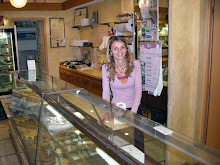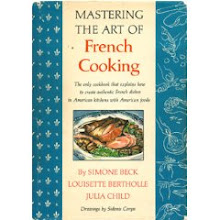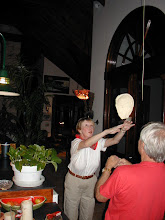Through the years I’ve made Chicken Marbella many times for dinner parties and it’s always a crowd pleaser. With its irresistible and alluring flavors, the chicken with pieces of dark fruit, green olives and capers scattered over, napped with a slightly sweet and savory sauce, the inevitable question poised at the dinner table is always, “What IS this? It’s fantastic.”
Well, start with lots of garlic, vinegar, oregano, brown sugar, wine, capers and briny green olives, dried prunes, or plums as they are now called, and marinate with chicken overnight. Bake in the oven and it couldn’t be an easier dish to prepare. It practically makes itself. It’s perfect served hot, at room temperature, or cold. Could you ask for anything more?
Chicken Marbella was one of the most popular recipes ever to come from the wildly successful Silver Palate Cookbook, which recently published its 25 anniversary edition. The original recipe called for cut up chicken, but in today’s world, if I were making it for a dinner party, I would probably use boneless, skinless chicken thighs or cut in half bone-in chicken breasts. If you're serving it for a dinner party, it is excellent over couscous or rice with baby English peas. A nice accompaniment is an French fresh orange salad, link to recipe here.
But herein is our dilemma. We needed a dish to take to our condo’s Christmas party at the pool the other night and it needed to be a dish that people would be able to serve themselves in small portions, hold up well on a buffet, and allow to be eaten with one of those pitiful plastic forks they invariably give you as these kinds of events. Thus the reincarnation of Chicken Marbella that I present today. Sliced chicken breasts seemed like the perfect solution and it was. Everyone raved about it, as what always happens when you serve Chicken Marbella. Even 25 years since The Silver Palate first published this recipe, there are still those among us who have never, ever tasted Chicken Marbella and some of them were at this party. There’s no shame in that. It's fun to introduce new people to Chicken Marbella. But their first reaction is still the same as it’s always been – “What IS this? It’s fantastic.”
Make people happy - serve this at your next buffet. Nothing could be easier or more of a “people pleaser” than the intriguing and exotic Chicken Marbella. I don’t know anyone who doesn’t love this dish and it always distinguishes itself among the other buffet offerings “the very best of the best.”
Chicken Marbella recreated into cocktail food for a party buffet
Adapted From The Silver Palate Cookbook
6 large plump boneless skinless chicken breasts halves
½ head of garlic, peeled & finely pureed
¼ cup dried oregano
Kosher salt & freshly ground pepper to taste
½ cup red wine vinegar
½ cup extra virgin olive oil
1 cup pitted dried prunes or dried plums as they are now called, bite size preferred, or large ones cut in bite size pieces
½ cup pitted Spanish green olives
½ cup capers with a bit of juice
6 bay leaves
1 cup brown sugar
1 cup dry white wine
¼ cup Italian parsley or fresh coriander (cilantro), finely chopped
In a large bowl combine chicken, garlic, oregano, pepper and coarse salt to taste, vinegar, olive oil, prunes, olives, capers & juice and bay leaves. Cover and let marinate, refrigerated, overnight.
Preheat oven to 350 degrees F.
Arrange chicken in a single layer in one or two large, shallow baking pans and spoon marinade over it evenly. Sprinkle chicken with brown sugar and pour white wine around the chicken. Bake for 50 minutes to 1 hour, basting frequently with pan juices. Chicken is done when it registers 160 degrees F on an oven thermometer.
Remove the chicken breasts and slice into serving pieces. Transfer sliced chicken, and with a slotted spoon, transfer prunes, olives and capers over chicken to a serving platter. Discard the bay leaves. Moisten the chicken with a few spoonfuls of pan juices and sprinkle generously with parsley or cilantro. Pass remaining pan juices in a sauce boat.
Good served hot, at room temperature, or cold. To serve cold, cool to room temperature in cooking juices before transferring to a serving platter. If chicken has been covered and refrigerated, allow it to return to room temperature before serving. Spoon some of the reserved juice over chicken.
Notes: Don’t skip the overnight marinating; it’s essential for flavor. If in a hurry, marinate at least 4 hours. To turn back into the original recipe, use two whole chickens cut into serving pieces, or quartered, or any combination of chicken parts, including halved breasts or all thighs. Either version is good hot, cold or room temperature.
This will be shared with Foodie Friday at Rattlebridge Farms, Miz Helen’s Country Kitchen Full Plate Thursday, Foodie Friday at Simple Recipes, Foodtastic Friday at Not Your Ordinary Recipes, and On the Menu Monday at Stone Gable.
Have a great weekend everyone.























































































